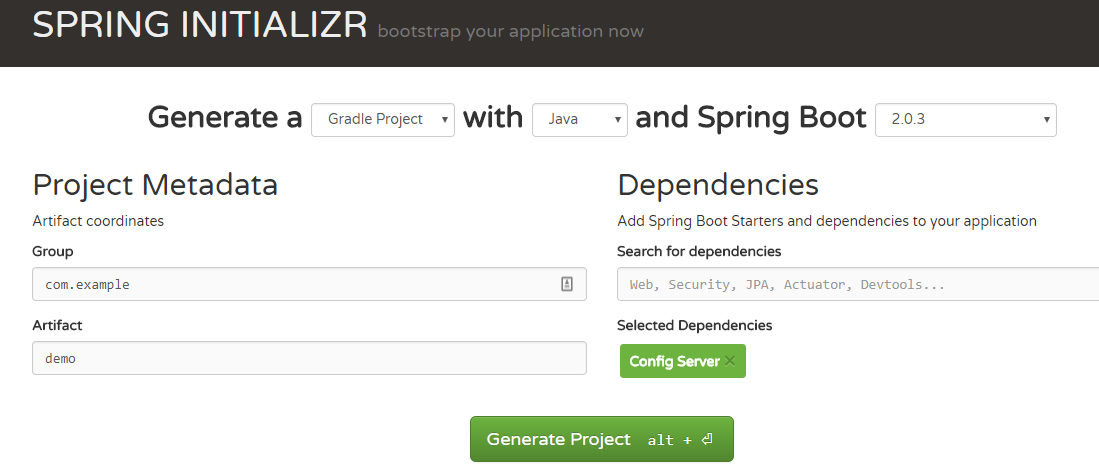
引言
最近用 Go 写后端写得很开心, 写篇比较实用的博客总结下如何通过 Spring Cloud Config Server 管理 Go 程序中的配置. 实现并不复杂, 因此也可以很轻易地推广到其他语言的程序中.
先来说说为什么要做集中配置管理. 在单体应用时代配置管理并不是什么大问题, 一般配置文件就和源码一起放在代码仓库中, 要查看或者修改直接到 conf 目录里找就完事儿了. 但到了微服务时代, 服务的数量比过去多了几十倍, 再到茫茫多的代码仓库里找配置可就没这么简单了. 因此我们需要一个能够统一查看修改配置, 能够对配置进行版本控制的地方, 这就是配置中心了.
在 Google 上搜索 "配置中心" 能找到不少不错的开源软件, 但大部分都比较重, 并且需要引入特定的客户端. 这对没到那么大规模的中小团队来说未免太过折腾. 因此反而像 Spring Cloud Config Server 这样的轻量级配置中心比较适合, 几分钟就能跑起来, 而且和配置本身相关的功能也足够丰富了.
因此我们的架构就像下面这样:
- Git: 储存具体的配置文件, 并且负责配置版本管理
- Spring Cloud Config Server: 提供配置的查询接口
- Go App: 从配置中心载入配置并使用
OK, 下面正式开干吧.
简单的搜索服务
作为演示我们用 Go 写一个很简单的搜索服务. 只要访问 GET /search?q=<keyword> 服务就会把搜索引擎查到的结果展示出来. 用 Go 实现只要一个文件哦 ~
main.go
package mainimport ...func main() { http.HandleFunc("/search", func(w http.ResponseWriter, req *http.Request) { q := req.URL.Query().Get("q") fmt.Fprintf(w, ` 接着把服务跑起来:
go run main.go
在浏览器中访问 http://localhost:8081/search?q=golang

很简单是不是? 但这里的问题在于我们把 https://cn.bing.com 写死在了代码中, 如果要切换搜索引擎就得重新编译程序, 真的是费时费力. 这时候我们就需要将配置解耦到配置文件中了.
配置文件
我们先在本地建一个配置文件 go-app.yml
app: search_url: https://cn.bing.com/search?q=%v
然后通过 viper 这个比较流行的配置库加载这个配置
conf/conf.go
package confimport ...func init() { viper.SetConfigName("go-app") viper.AddConfigPath(os.ExpandEnv(`$GOPATH\src\github.com\GotaX\config-server-demo`)) viper.SetConfigType("yaml") if err := viper.ReadInConfig(); err != nil { log.Fatal("Fail to load config", err) }} 现在我们就把搜索引擎的地址解耦到配置文件中去了
main.go
package mainimport ...func main() { http.HandleFunc("/search", func(w http.ResponseWriter, req *http.Request) { q := req.URL.Query().Get("q") src := fmt.Sprintf(viper.GetString("app.search_url"), q) fmt.Fprintf(w, ` 转移配置到云端
接下来我们将配置文件从本地转移到 Git 中, 处于方便我就直接放在当前仓库的 config 分支中了.
地址为:
启动配置中心
配置文件上传完毕, 我们再新开一个 config-server 空分支搭建配置中心.
首先到 页面新建一个 Java + Gradle 的 Spring Boot 工程, 依赖项选 Config Server

点击 "Generate Project" 将下载压缩包, 并解压.
修改 Application.java
package com.example.demo;import org.springframework.boot.SpringApplication;import org.springframework.boot.autoconfigure.SpringBootApplication;import org.springframework.cloud.config.server.EnableConfigServer;@EnableConfigServer // 添加这行@SpringBootApplicationpublic class DemoApplication { public static void main(String[] args) { SpringApplication.run(DemoApplication.class, args); }} 修改 application.yml, 填入我们存放配置文件的仓库地址
spring.cloud.config.server.git.uri: https://github.com/GotaX/config-server-demo.git
在工程根目录启动 config server
gradle bootrun
访问 http://localhost:8080/config/go-app-default.yml 查看配置
app: search_url: https://cn.bing.com/search?q=%v
这样我们的配置中心就启动完毕了
在 Go 应用中读取配置
最后就是在应用中使用 Spring Cloud Config Server 中的配置了. 如果是基于 Spring Boot 的应用可以直接使用 spring-cloud-config-client 加载配置. 在 Go 中就需要稍微写点代码了, 不过并不多.
我们先在 config.go 中添加一个 loadRemote() 函数, 用来从配置中心读取配置
conf/conf.go
// ...const ( kAppName = "APP_NAME" kConfigServer = "CONFIG_SERVER" kConfigLabel = "CONFIG_LABEL" kConfigProfile = "CONFIG_PROFILE" kConfigType = "CONFIG_TYPE")func loadRemoteConfig() (err error) { // 组装配置文件地址: http://localhost:8080/config/go-app-default.yaml confAddr := fmt.Sprintf("%v/%v/%v-%v.yml", viper.Get(kConfigServer), viper.Get(kConfigLabel), viper.Get(kAppName), viper.Get(kConfigProfile)) resp, err := http.Get(confAddr) if err != nil { return } defer resp.Body.Close() // 设置配置文件格式: yaml viper.SetConfigType(viper.GetString(kConfigType)) // 载入配置文件 if err = viper.ReadConfig(resp.Body); err != nil { return } log.Println("Load config from: ", confAddr) return} 当然, 我们需要知道配置中心的入口, 因此还需要一个 initDefault() 函数来初始化这些配置
conf/conf.go
func initDefault() { viper.SetDefault(kAppName, "go-app") viper.SetDefault(kConfigServer, "http://localhost:8080") viper.SetDefault(kConfigLabel, "config") viper.SetDefault(kConfigProfile, "default") viper.SetDefault(kConfigType, "yaml")} 现在我们的 init() 函数变成了这样
conf/conf.go
func init() { viper.AutomaticEnv() initDefault() if err := loadRemoteConfig(); err != nil { log.Fatal("Fail to load config", err) }} 其中的 viper.AutomaticEnv() 可以让我们通过环境变量修改任意配置, 因此 initDefault() 中的配置也不是写死在代码中的了. 其中比较常见的用法是通过 CONFIG_PROFILE=prod 环境变量来切换 profile
最后我们希望 viper 仅在 conf 包中出现, 而对外隐藏我们加载配置的具体实现. 因此我们将配置读到结构体中再对外提供.
conf/conf.go
var App AppConfigtype AppConfig struct { SearchUrl string `mapstructure:"search_url"`}func init() { // ... if err := sub("app", &App); err != nil { log.Fatal("Fail to parse config", err) }}func sub(key string, value interface{}) error { sub := viper.Sub(key) sub.AutomaticEnv() sub.SetEnvPrefix(key) return sub.Unmarshal(value)} 这时我们就可以从 main.go 中去掉 viper.Get() 调用了
main.go
import ...func main() { http.HandleFunc("/search", func(w http.ResponseWriter, req *http.Request) { q := req.URL.Query().Get("q") src := fmt.Sprintf(conf.App.SearchUrl, q) fmt.Fprintf(w, ` 总结
我们通过 Git + Spring Could Config Server + Viper + 少量 Go 代码, 实现了基于配置中心的配置管理及使用
我们甚至可以在 Go 中使用类似于 Spring Boot 的 Profile 管理, 对比下:
完整的代码可以参考 下的 3 个分支:
- config: 配置文件
- config-server: 配置中心
- app: Go 应用
当然, 目前这种使用方式还比较简陋, 还有很多可以改进的地方, 比如:
- 结合 Spring Cloud Bus 实现配置的实时推送
- 结合 Spring Cloud Eureka 实现配置服务器的高可用
- 监听 SIGINT 和 SIGTERM 实现 Go 应用优雅退出
有机会的话下次再写, 或者也可以直接参考 Spring Cloud Config Server 的
如果你有疑问或者更好的想法, 实践, 欢迎留言讨论